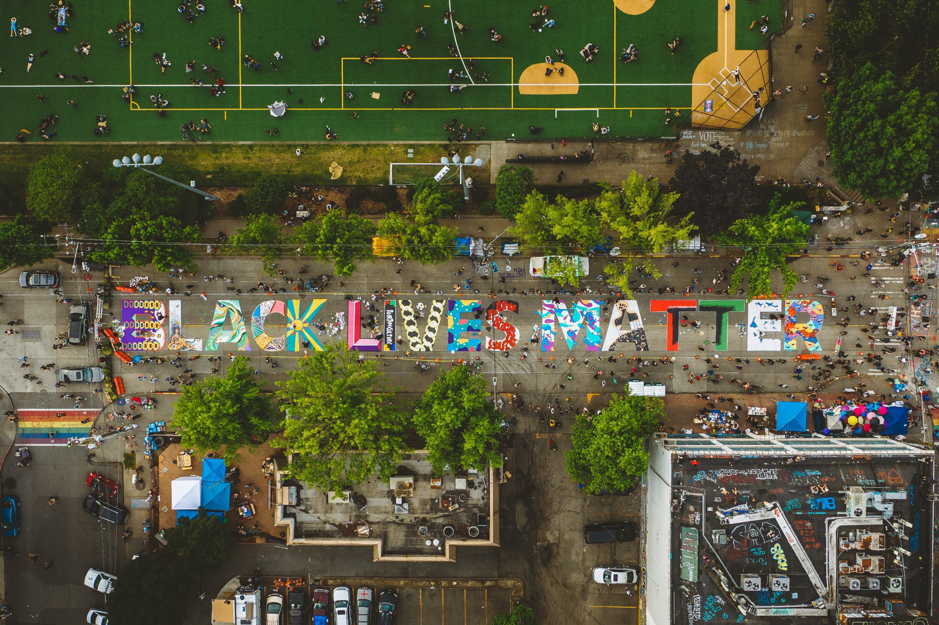#UDGLOBAL The "Black Lives Matter" Protests: Placemaking by the People
- nurul azreen azlan
- Jul 21, 2020
- 4 min read

The Black Lives Matter autonomous zone in Seattle. Source: Kyle Kotajarvi / CC BY-SA (https://creativecommons.org/licenses/by-sa/3.0)
Almost overnight, the streets and squares emptied by the Covid-19 lockdown were filled with people protesting against the injustice faced by black lives. Triggered by the tragedy of George Floyd, who died of suffocation at the hands of a police officer, the protest quickly spread globally, resulting in the toppling of colonial slave trader Edward Colston’s statue in Bristol, the UK. In Washington D.C, ‘Black Lives Matter’ was painted in huge yellow characters on a street surface, and the street was renamed Black Lives Matter Plaza by the Mayor. While the statue of Robert E. Lee, a Confederate general, was not pulled down, the plinth was heavily gratified. After dark, the iconic image of George Floyd was projected onto the plinth - - the space has become a site of occupation by the BLM protesters. In these moments, when these streets and squares were taken over by the people, they truly became public spaces.
While the use of public space for occupying and marching are typical protest repertoires, it was the toppling and defacement of statues – who were often of colonial figures – that elicited a strong response. Some argued that toppling these statues was a denial of history – just because you do not like something does not mean it did not take place. Others agreed that these figures were terrible, but argued for the statues to stay put for the sake of learning history, and perhaps the plaque could be re-written to impart the role these figures played in the history of colonialism. Conversely, for those who deal with heritage and urban design, statues such as these would have been a landmark feature that hugely contributes to the character of a place, so the toppling of these statues, admittedly of horrible people, presents a dilemma. As people who are involved in the making and shaping of places, how do we deal with this phenomenon?

For those who study archaeology, the tendency to preserve artefacts of the material culture is strong, but even then it has been argued that these toppling of statues is but a moment in history, and not its erasure. There have been many instances in history where statues were toppled and defiled, often in tandem with major turning points. In many cities, to place these figures prominently in public spaces where they become part of our everyday life is to celebrate the ideology they symbolise. Once they are part of the landscape, they would require maintenance, which means that a portion of public money that could be used for other purposes, would be allocated to the upkeep of a considered racist monument.
Perhaps what could be useful is to look at who erected these statues, and for what purpose. Take Edward Colston. His statue was erected in 1895, more than 100 years after his death (1721). This means that somebody took a look at history, and decided that a statue should be erected in the likeness of Edward Colston, the great philanthropist who basically built Bristol, despite his role in the slave trade. So, would topple his statue in 2020 means a denial of history? Or could it be the beginning of reconciliation, an admission that his wealth was built on the death and suffering of many people? And what does it mean for the space it used to occupy?
Let’s look at it from the perspective of public space discourse. Public space is often understood in terms of access and ownership. For example, a privately-owned space such as a shopping mall can be accessed by the public, and in this case, even depends on public access to function. A publicly owned structure, on the other hand, can have limited access, an example of this would be the parliament house.
But there is another dimension to the publicness of space, that is the aspect of citizenship. As the geographer, Don Mitchell argued, what makes a space public is not the predetermined label we assign spaces, but space becomes public when a group of people takes it and through their actions makes it public. Representation both demands space and creates space (Mitchell, 2003: 35). And so it can be argued that in those moments when the protesters were marching, occupying, and remaking those spaces, they became public spaces in the truest sense. The projection of George Floyd’s image onto the plinth of Robert E. Lee’s statue is powerful because at that moment, the balance of power shifted, and attention – a precious commodity these days – was trained upon the plight of black people in the United States. Similarly, the creation of an autonomous zone in Seattle, where colourful Black Lives Matter was painted on the street and protesters occupied the area, was reminiscent of the Paris Commune of 1871. This is placemaking, from the bottom up.
The built environment is dynamic, it undergoes constant change. While it is perhaps counterintuitive to the designer’s mind to let space be defined by those who are using it, publicness is not marked by how beautiful or how grand space is. They can also be redefined and reshaped by people. If a space becomes messy after a protest, it can always be cleaned up. What is harder is to instil the realisation that public space is not just for leisure or consumption, but it is also a political space. The challenge of the urban designer in this instance is not to solely focus on aesthetics, but more importantly, in how to create truly robust spaces that can host many different functions without losing the soul of the place.











Comments